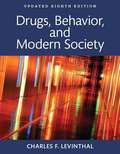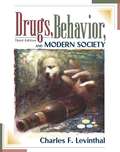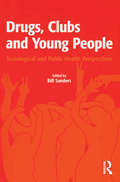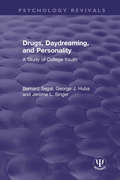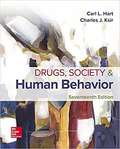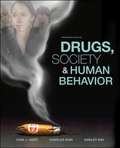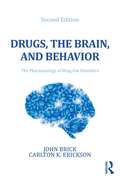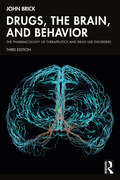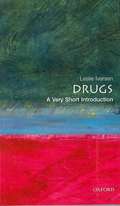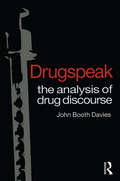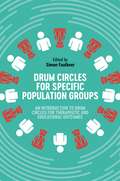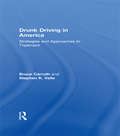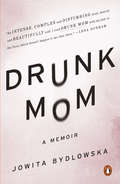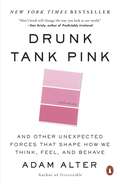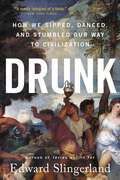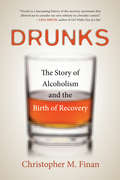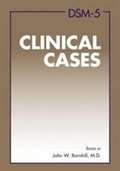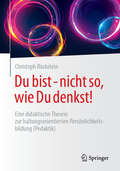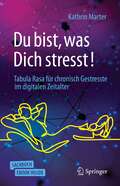- Table View
- List View
Drugs, Behavior, And Modern Society
by Charles LevinthalThe eighth edition of Drugs, Behavior, and Modern Society examines the impact of drug-taking behavior on our society and our daily lives. The use and abuse of a wide range of licit and illicit drugs are discussed from historical, biological, psychological, and sociological perspectives. In today's world, drugs and their use present a social paradox, combining the potential for good and for bad. As a society and as individuals, we can be the beneficiaries of drugs or their victims. This text features a comprehensive review of psychoactive drugs, and is notable for the attention it gives to two aspects of drug-taking behavior that have been underreported in other texts: steroid abuse and inhalant abuse.
Drugs, Behavior, and Modern Society (3rd Edition)
by Charles F. LevinthalAn introduction to many of the controversies related to drug use and abuse with a focus on health and prevention.
Drugs, Clubs and Young People: Sociological and Public Health Perspectives
by Bill SandersIn this volume, contributors employ sociological and public health perspectives to offer insights into behaviours common at raves and nightclubs. The volume provides theoretical observations on illicit club drug use and supply, helping to challenge current orthodoxies on the role of drug use within young peoples' lives. Drawing material from the USA, UK and Hong Kong, the volume allows the demystification of stereotypical presentations surrounding young people who attend clubs and/or use club drugs. This work provides a badly needed and objective analysis of youthful drug use, and a foundation from which future sociological and public studies on young people, clubs and drugs - as well as young people themselves - will benefit.
Drugs, Daydreaming, and Personality: A Study of College Youth (Psychology Revivals)
by Jerome L. Singer Bernard Segal George J. HubaOriginally published in 1980, this book presents a detailed account of a series of investigations that examined the patterns of resort to drugs and alcohol use in college youth, and how such substance uses are linked to personality characteristics and daydreaming patterns. The Editors chose to emphasize the more "private" features of the personality, because these had often been ignored in earlier research, despite popular assumptions that there are close ties between fantasy, inwardness, "spacey" qualities (all suggesting permanent changes in mental organization), and substance use in youth. This volume will be of interest to a wider audience than just drug and alcohol researchers, because of the effort to go beyond normative patterns of substance use toward explorations of personality and consciousness.
Drugs, Society and Human Behavior
by Charles Ksir Carl HartDrugs, Society and Human Behavior provides the latest information on drug use and its effects on society as well as on the individual. Trusted for more than 40 years by both instructors and students, this authoritative resource examines drugs and drug use from a variety of perspectives--behavioral, pharmacological, historical, social, legal, and clinical. The 16th edition includes the very latest information and statistics and many new timely topics and issues have been added that are sure to pique students' interest and stimulate class discussion.
Drugs, Society, and Human Behavior
by Carl L. Hart Charles J. KsirDrugs, Society and Human Behavior provides the latest information on drug use and its effects on society as well as on the individual. Trusted for more than 40 years by both instructors and students, this authoritative resource examines drugs and drug use from a variety of perspectives―behavioral, pharmacological, historical, social, legal, and clinical. The 17th Edition includes the very latest information and statistics and many new timely topics and issues have been added that are sure to pique students’ interest and stimulate class discussion.
Drugs, Society, and Human Behavior (13th edition)
by Carl L. Hart Charles Ksir Oakley RayDesigned for the introduction to drugs and substance abuse course as taught in departments of health education, psychology, biology, sociology, and criminal justice, this full-color market-leading text provides the latest information on drugs and their effects on society and human behavior.
Drugs, the Brain, and Behavior: The Pharmacology of Drug Use Disorders
by Carlton K. Erickson John BrickExplore the brain and discover the clinical and pharmacological issues surrounding drug abuse and dependence. The authors, research scientists with years of experience in alcohol and drug studies, provide definitions, historic discoveries about the nervous system, and original, eye-catching illustrations to discuss the brain/behavior relationship, basic neuroanatomy, neurophysiology, and the mechanistic actions of mood-altering drugs. You will learn about:• how psychoactive drugs affect cognition, behavior, and emotion• the brain/behavior relationship • the specific effects of major addictive and psychoactive drug groups • new definitions and thinking about abuse and dependence• the medical and forensic consequences of drugs use Drugs, the Brain, and Behavior uses a balance of instruction, illustrations, and tables and formulas that will give you a broad, lasting introduction to this intriguing subject. Whether you're a nurse, chemical dependency counselor, psychologist, or clinician, this book will be a quick reference guide long after the first reading.
Drugs, the Brain, and Behavior: The Pharmacology of Therapeutics and Drug Use Disorders
by John BrickThis third edition of Drugs, the Brain, and Behavior provides a comprehensive overview of the brain and explores the clinical and pharmacological issues surrounding drug abuse and dependence.Dr Brick provides definitions, historic discoveries about the nervous system, and original, eye-catching illustrations to discuss the brain/behavior relationship, basic neuroanatomy, neurophysiology, and the mechanistic actions of mood-altering drugs. Topics include: how psychoactive drugs affect cognition, behavior, and emotion; the brain/behavior relationship; the specific effects of major addictive and psychoactive drug groups; new definitions and thinking about abuse and dependence; and the medical uses of drugs, such as cannabinoids. A new chapter on biobehavioral markers explores how markers can guide the clinician in the diagnosis of some disorders. This book offers a quick reference guide which uses a balance of instruction, illustrations, tables, and formulas, that will give you a broad, lasting introduction to this intriguing subject.Drugs, the Brain, and Behavior is an invaluable resource for students in the field, nurses, psychologists, counsellors, physicians and other health care professionals.
Drugs: A Very Short Introduction
by Leslie IversenThe book gives a non-technical account of how drugs work in the body. The twentieth century saw a remarkable upsurge of research on drugs, with major advances in the treatment of bacterial and viral infections, heart disease, stomach ulcers, cancer, and metal illnesses. These, along with the introduction of the oral contraceptive, have altered all of our lives. There has also been an increase in the recreational use and abuse of drugs in the Western world. The book reviews both legal (alcohol, nicotine, and caffeine) and illegal drugs and discusses current idea about why some are addictive, and whether drug laws need reform.
Drugs: Mind, Body, and Society
by Martha RosenthalWritten in a contemporary and accessible voice, Drugs: Mind, Body, and Society offers more than knowledge and study skills. It is a multidisciplinary text that provides students with a comprehensive discussion about drugs and drug effects that weaves together physiology, neuroscience, pharmacology, psychology, society, culture, media, history, law, and religion. With an emphasis on critical thinking skills, this book teaches students to evaluate research, assess sources of data, and discern fact from opinion, so that they can make intelligent decisions that improve the quality of their lives. <P><P>FEATURES *"Thinking Critically About Drugs," a separate section at the start of the book, teaches students how to evaluate data, validate sources, and understand how drug research is conducted *True/False chapter-opening questions, with answers, draw students into the material by asking them provocative questions that challenge commonly held misconceptions about drugs *"Critical Evaluations" in most chapters delve into controversial topics and teach students to evaluate research and information from multiple perspectives *"Ask Yourself" questions encourage students to reflect on and discuss their own ideas about the chapter material *"Quick Hits" scattered throughout each chapter provide students with brief, interesting anecdotes or fun facts from various disciplines, like history and economics *"The Straight Dope" boxes feature historical and biographical profiles, cases, self-knowledge tests, and points of clinical or cultural relevance
Drugspeak: The Analysis of Drug Discourse
by John Booth DaviesDrugspeak The Analysis of Drug Discourse describes the way in which conversations between drug users vary and change according to context and circumstance in ways that suggest that there is no single truth about the state we call addicted. The central thesis of the book is that the explanations that drug users give for their drug use make sense not so much as sources of facts, but as primarily functional statements shaped by a climate of moral and legal censure. Consequently the significance of drug conversations lies not in their literal semantics but in the purposes such conversations serve. The argument raises a number of fundamental issues about the performative rather than the informative nature of language, about the nature of the scientific facts concerning drug use, and about the very nature of science itself. Starting with a general overview of the problems arising from a mechanistic and deterministic view of science, the book identifies a need for a new approach to the un
Drum Circles for Specific Population Groups: An Introduction to Drum Circles for Therapeutic and Educational Outcomes
by Simon FaulknerWith easy-to-follow instructions for group activities and rhythms, this book provides tools to lead drum circles effectively with people facing a wide variety of life challenges. Sections on outcomes, setting up for success, common challenges and practical adaptations of the drum circle guide you in leading sessions with your own groups. The compendium also offers guidance on pricing, evaluating your sessions, managing challenging behaviours and duty of care.Demonstrating the potential of this empowering creative activity in supporting therapeutic and developmental outcomes, this book equips you to meet the needs of different groups through the healing power of music.
Drunk Driving in America: Strategies and Approaches to Treatment
by Bruce Carruth Stephen K ValleThis unique volume discusses research, policy, and treatment approaches to one of America’s most serious problems--the drunk driver. The authors--many of the countries most dedicated professionals from academic, research, correctional, public health, and judicial system backgrounds--present an extraordinary array of creative and thought-provoking approaches to the drunk driver. Their thorough descriptions will help you better understand the drunk driver, and their exploration of new sentencing and treatment strategies provides a comprehensive look at the options to confronting and solving the problem of alcohol and traffic safety in the United States. Chapters challenge many long-held assumptions about those who drink and drive; address policy issues; examine the need for culturally specific education and training programs for police, court officials, and human service providers; and offer helpful suggestions for designing programs for women and adolescent offenders.
Drunk Mom
by Jowita BydlowskaA bestseller in its native Canada, Drunk Mom is a gripping, brutally honest memoir of motherhood in the shadow of alcoholism Three years after giving up drinking, Jowita Bydlowska found herself throwing back a glass of champagne like it was ginger ale. It was a special occasion: a party celebrating the birth of her first child. It also marked Bydlowska's immediate, full-blown return to crippling alcoholism. In the gritty and sometimes grimly comic tradition of the bestselling memoirs Lit by Mary Karr and Smashed by Koren Zailckas, Drunk Mom is Bydlowska's account of the ways substance abuse took control of her life- the binges and blackouts, the humiliations, the extraordinary risk-taking- as well as her fight toward recovery as a young mother. This courageous memoir brilliantly shines a light on the twisted logic of an addicted mind and the powerful, transformative love of one's child. Ultimately it gives hope, especially to those struggling in the same way.
Drunk Tank Pink: And Other Unexpected Forces That Shape How We Think, Feel, and Behave
by Adam AlterAn illuminating look at the way the thoughts we have and the decisions we make are influenced by forces that aren't always in our control Why are people named Kim, Kelly, and Ken more likely to donate to Hurricane Katrina victims than to Hurricane Rita victims? Are you really more likely to solve puzzles if you watch a light bulb illuminate? How did installing blue lights along a Japanese railway line halt rising crime and suicide rates? Can decorating your walls with the right artwork make you more honest? The human brain is fantastically complex, having engineered space travel and liberated nuclear energy, so it's no wonder that we resist the idea that we're deeply influenced by our surroundings. As profound as they are, these effects are almost impossible to detect both as they're occurring and in hindsight. Drunk Tank Pink is the first detailed exploration of how our environment shapes what we think, how we feel, and the ways we behave. The world is populated with words and images that prompt unexpected, unconscious decisions. We are so deeply attracted to our own initials that we give more willingly to the victims of hurricanes that match our initials: Kims and Kens donate more generously to Hurricane Katrina victims, whereas Rons and Rachels give more openly to Hurricane Rita victims. Meanwhile, an illuminated light bulb inspires creative thinking because it symbolizes insight. Social interactions have similar effects, as professional cyclists pedal faster when people are watching. Teachers who took tea from the break room at Newcastle University contributed 300 percent more to a cash box when a picture of two eyes hung on the wall. We're evolutionarily sensitive to human surveillance, so we behave more virtuously even if we're only watched by a photograph. The physical environment, from locations to colors, also guides our hand in unseen ways. Dimly lit interiors metaphorically imply no one's watching and encourage dishonesty and theft, while blue lights discourage violent activity because they're associated with the police. Olympic taekwondo and judo athletes are more likely to win when they wear red rather than blue, because red makes them behave aggressively and referees see them as more dominant. Drunk Tank Pink is full of revelatory facts, riveting anecdotes, and cutting-edge experiments that collectively explain how the most unexpected factors lead us to think, feel, and behave the way we do. .
Drunk Tank Pink: The Subconscious Forces that Shape How We Think, Feel, and Behave
by Adam AlterDrunk Tank Pink' is a particular shade of pink. In 1979 psychologists discovered that it has an extraordinary effect: if you stare at it for two minutes, you dramatically weaken in strength. In this brilliant study of the strange recesses of our minds, Adam Alter reveals the world is full of such hidden forces that shape our every thought, feeling and behaviour - without us ever realizing. Some letters in product names make us more likely to buy them (nearly all successful brands contain a 'k' sound) We're more likely to be critical if we write in red rather than green biro Your first report at school can determine your future career Understanding these cues is key to smarter decision-making, more effective marketing, and better outcomes for our selves and our societies. Prepare for the most astounding and fast-paced psychology book since Blink and Predictably Irrational.
Drunk: How We Sipped, Danced, and Stumbled Our Way to Civilization
by Edward SlingerlandA "entertaining and enlightening" deep dive into the alcohol-soaked origins of civilization—and the evolutionary roots of humanity&’s appetite for intoxication. (Daniel E. Lieberman, author of Exercised) While plenty of entertaining books have been written about the history of alcohol and other intoxicants, none have offered a comprehensive, convincing answer to the basic question of why humans want to get high in the first place. Drunk elegantly cuts through the tangle of urban legends and anecdotal impressions that surround our notions of intoxication to provide the first rigorous, scientifically-grounded explanation for our love of alcohol. Drawing on evidence from archaeology, history, cognitive neuroscience, psychopharmacology, social psychology, literature, and genetics, Slingerland shows that our taste for chemical intoxicants is not an evolutionary mistake, as we are so often told. In fact, intoxication helps solve a number of distinctively human challenges: enhancing creativity, alleviating stress, building trust, and pulling off the miracle of getting fiercely tribal primates to cooperate with strangers. Our desire to get drunk, along with the individual and social benefits provided by drunkenness, played a crucial role in sparking the rise of the first large-scale societies. We would not have civilization without intoxication. From marauding Vikings and bacchanalian orgies to sex-starved fruit flies, blind cave fish, and problem-solving crows, Drunk is packed with fascinating case studies and engaging science, as well as practical takeaways for individuals and communities. The result is a captivating and long overdue investigation into humanity's oldest indulgence—one that explains not only why we want to get drunk, but also how it might actually be good for us to tie one on now and then.
Drunks: An American History
by Christopher M. FinanA social history of alcoholism in the United States, from the seventeenth century to the present dayToday, millions of Americans are struggling with alcoholism, but millions are also in long-term recovery from addiction. Alcoholics Anonymous and a growing number of recovery organizations are providing support for alcoholics who will face the danger of relapse for the rest of their lives. We have finally come to understand that alcoholism is a treatable illness. But in the beginning, our nation condemned drunks for moral weakness. President John Adams renounced his alcoholic son, Charles, and refused to bury him in the family crypt.Christopher Finan reveals the history of our struggle with alcoholism and the emergence of a search for sobriety that began among Native Americans in the colonial period. He introduces us to the first of a colorful cast of characters, a remarkable Iroquois leader named Handsome Lake, a drunk who stopped drinking and dedicated his life to helping his people achieve sobriety. In the early nineteenth century, the idealistic and energetic “Washingtonians,” a group of reformed alcoholics, led the first national movement to save men like themselves. After the Civil War, doctors began to recognize that chronic drunkenness is an illness, and Dr. Leslie Keeley invented a “gold cure” that was dispensed at more than a hundred clinics around the country. But most Americans rejected a scientific explanation of alcoholism. A century after the ignominious death of Charles Adams came Carrie Nation. The wife of a drunk, she destroyed bars with a hatchet in her fury over what alcohol had done to her family. Prohibition became the law of the land, but nothing could stop the drinking.Finan also tells the dramatic story of Bill Wilson and Dr. Bob Smith, who helped each other stay sober and then created AA, which survived its tumultuous early years and finally proved that alcoholics could stay sober for a lifetime. This is narrative history at its best: entertaining and authoritative, an important portrait of one of America’s great liberation movements.
Dsm-5 (R) Casebook and Treatment Guide for Child Mental Health
by Peter S. Jensen Cathryn A. GalanterDSM-5(R) Casebook and Treatment Guide for Child Mental Health offers trainees and clinicians who provide mental health services to children and adolescents a concise but conceptually and clinically rich guide to the types of disorders commonly found in practice. The cases are either new or updated from the previous publication, which was designed as a child mental health casebook for DSM-IV-TR, and were chosen to illustrate advances in diagnosis and evidence-based assessment and treatment with DSM-5 in mind. For each case, commentaries are included from a child and adolescent psychiatrist and child psychologist (or another mental health professional), who review each vignette and address diagnostic formulation and treatment from both psychotherapeutic and psychopharmacologic perspectives, with attention to other modalities that might be important for clinical management. This panel approach allows for a diversity of perspectives and provides valuable, complementary insights into each case. <p><p> The book is structured in a logical, user-friendly way, with many features that facilitate and enhance learning: - Cases are divided into four sections, each with an introduction by the editors, who summarize and contextualize the information presented in that part, providing a framework for understanding and building bridges to the other sections.- The 29 case vignettes are fascinating, instructive, and diverse. The cases range from fairly clear diagnoses, to more complex presentations (such as when patients with comorbid conditions), to the most difficult cases (when the diagnosis is unclear, the patient has not responded to previous treatment, only limited evidence is available on the correct means of treatment, and/or the patient's psychopathology occurs in the context of extreme psychosocial stressors).- The book's final part addresses diagnostic and treatment decision making and includes two chapters on clinical and research issues in the diagnosis and treatment of child psychopathology. <p><p> The book's cross-disciplinary approach makes it appropriate for clinicians and trainees from all disciplines who are involved in treating children and adolescents with mental health problems. DSM-5(R) Casebook and Treatment Guide for Child Mental Health is unparalleled in its engaging style, up-to-date information, and expert, evidence-based guidance in conceptualizing diagnosis and treatment.
Dsm-5 And Family Systems
by J. Kelly Coker Jessica A. Russo Jason H. KingThe first text to present DSM-5 diagnoses within a relational perspective, DSM-5 and Family Systems delivers timely content aimed at training marriage and family therapists, clinical mental health counselors, and other systems-oriented practitioners. It reflects how the DSM-5 examines, for the first time, its diagnostic categories from the perspective of cultural and environmental impact on the development of individual disorders and conditions. This comprehensive text provides students with an understanding of how to approach a diagnosis as it relates to assessments, treatment planning, and ethical implications from a family and relational systems perspective. With contributions from distinguished faculty at counseling and marriage and family therapy training programs, each chapter includes an overview of the DSM in family systems contexts, cultural aspects, family systems assessments and interventions, and ethical and legal implications. Abundant case vignettes aid students in conceptualizing diagnoses in each DSM-5 category.
Dsm-5-tr® Handbook Of Differential Diagnosis
by Michael B. FirstThe DSM-5-TR Handbook of Differential Diagnosis is the preeminent guide to differential diagnosis for both clinicians and students learning psychiatric diagnosis. Fully updated to reflect the recent Diagnostic and Statistical Manual of Mental Disorders, Fifth Edition, Text Revision (DSM-5-TR), this handbook includes two newly developed diagnostic trees (for dissociative symptoms and repetitive pathological behaviors). This indispensable guide offers a rich selection of diagnostic lenses through which to consider symptomatic presentations, grounded in the latest research and standards of practice. Written by the DSM-5-TR Editor, an expert on psychiatric diagnosis and assessment, the handbook guides clinicians and students on how to differentiate between disorders with similar presentations in an accessible, easy-to-use format. An assortment of approaches to differential diagnosis and a number of features designed to benefit the evaluation include: • A six-step framework for diagnosing patients that proceeds from determining if the presenting symptoms are due to a substance/medication or a medical condition, to establishing the boundary between disorder and normality, to determining the primary disorder, and differentiating adjustment disorders from other mental disorders. • Thirty symptom-oriented decision trees, two of which are new to this edition, that provide detailed decision points to facilitate the process of generating the differential diagnosis based on the presenting symptoms and eliminate formulating premature conclusions. • Sixty-seven differential diagnosis tables, one for each of the most important disorders in DSM-5-TR, cross-referenced with the terminal branches of the decision trees presented in the handbook and that provide a head-to-head comparison of each disorder, highlighting similarities and differences. • The DSM-5-TR Classification, to facilitate coding and to provide an overview of all the DSM-5-TR diagnoses that must be considered in formulating a differential diagnosis. DSM-5-TR Handbook of Differential Diagnosis provides a comprehensive overview of the process of diagnosing DSM-5-TR disorders while serving as a reference guide to assist in the differential diagnosis of individual patients. Clinicians and students learning psychiatric diagnosis faced with this most crucial task will find this handbook of enormous benefit.
Dsm-5® Clinical Cases
by John BarnhillDSM-5® Clinical Cases presents patient cases that exemplify the mental disorders categorized in the newly released DSM-5®, bringing DSM-5® alive for teachers and students of psychiatry, psychology, social work, nursing, and related mental health and healthcare fields. Cases are cross-referenced with DSM-5® and help the reader understand diagnostic concepts, including symptoms, severity, comorbidities, age of onset and development, dimensionality across disorders, and gender and cultural implications. <P><P> Every feature in the book helps to bridge the distance between the formal classification and the real-life presentation of patients: <P><P> * All cases are original and previously unpublished, making for fresh, compelling reading for both experienced clinicians and those new to diagnostic classification. Case authors were selected for their expertise in the disorder described in the case. For ease in identifying specific cases, case titles are clinically relevant, based on the primary complaint, and identify the DSM-5® diagnosis described.* Each case adheres to a consistent format developed by the editors to fully illuminate the disorder being profiled. Features may include history of present illness, family psychiatric history, medical history, mental status exam results, DSM-5® diagnostic features, lab and physical findings, and a summary.* A brief discussion follows each case, analyzing the clinical presentation, highlighting key points, and exploring issues of comorbidity that may complicate both the diagnosis and subsequent treatment. This approach is especially helpful since few cases in real-life are unambiguous.* Easy-to-use appendixes enable readers to locate cases by type of disorder, special interests, and DSM-5® diagnosis.* The book is designed to serve as a companion text in a variety of contexts -- from abnormal psychology courses to medical school and residency training programs. In addition, those studying for specialty examinations will find reviewing the cases very useful. <P><P> Fascinating, practical, and instructive, DSM-5® Clinical Cases succeeds in bringing the DSM-5® to the examining room.
Du bist - nicht so, wie Du denkst!: Eine didaktische Theorie zur haltungsorientierten Persönlichkeitsbildung (Pedaktik)
by Christoph RöckeleinIn diesem Buch wird die didaktische Basistheorie einer haltungsorientierten Persönlichkeitsbildung in ihren einzelnen Elementen vorgestellt und am Schluss des Buches im Handlungsfeld des haltungsbasierten Coaching gezeigt. Im Kontext der von Christoph Röckelein konzipierten Pedaktik liegt der Schwerpunkt des Interesses auf der Coaching- bzw. der Beratungssituation, also auf persönlichkeitsbildenden Interaktionen. Das Innovative des pedaktischen Ansatzes ist, dass die Haltung im Fokus der Persönlichkeitsbildung steht. Diese Bildungsarbeit kann nur gelingen, wenn der Coach die Haltung, die er vermitteln will, selbst internalisiert hat. Diese Form der Interaktion könnte man auch als (Hin-)Führung zur Selbstführung bezeichnen.
Du bist, was Dich stresst!: Tabula Rasa für chronisch Gestresste im digitalen Zeitalter (Über/Strom: Wegweiser durchs digitale Zeitalter)
by Kathrin MarterViele Menschen nutzen täglich die Vorteile des digitalen Zeitalters: wenn sie mal eben ihr Zugticket mit dem Smartphone buchen, sich von ebendiesem zum vereinbarten Treffpunkt navigieren lassen und dann per Textnachricht erfahren, dass die werten Kolleg*innen ein paar Minuten zu spät kommen, der Tisch im Restaurant online schon reserviert wurde und das „Tisch-Ticket“ per QR-Code gleich mitsenden. Viele Menschen erfahren sich bei aller Erleichterung zunehmend reizüberflutet, überfordert und in der Folge gestresst.Der Begriff und Zustand „Stress“ (heutzutage im Sprachjargon als diffus definierter Normalzustand verankert und schon lange in der Mitte der Gesellschaft angekommen) ist allerdings tatsächlich ein Zustand, der vielfältigen Leidensdruck verursacht und krank macht.Die Autorin unterstützt allgemeinverständlich, anschaulich sowie naturwissenschaftlich und psychologisch fundiert bei der Auseinandersetzung mit Stress, Stressoren und Prozessen der Langzeitgedächtnisbildung. Letztere sind nicht unwesentlich an unserem chronischen Stresslevel beteiligt. Langzeitgedächtnisse, die, häufig schon in der Kindheit geformt, starke negative Glaubenssätze beinhalten. Diese negativen Glaubenssätze erfahren durch die Herausforderungen der digitalen Welt permanente Verstärkung und begünstigen dadurch chronischen Stress - mit seinen für viele Menschen spürbaren Folgen.Das Buch lädt ein, klärt auf und gibt fundierte, anschauliche und handlungsorientierte Ansätze zur Selbstreflexion und Entwicklung einer gesunden Handlungskompetenz gegenüber dem eigenen Stresslevel, folglich der eigenen Gesundheit und dem eigenen Glück.
